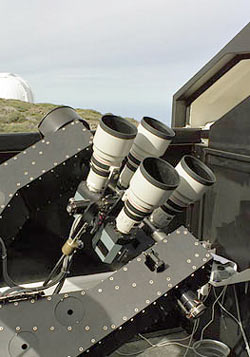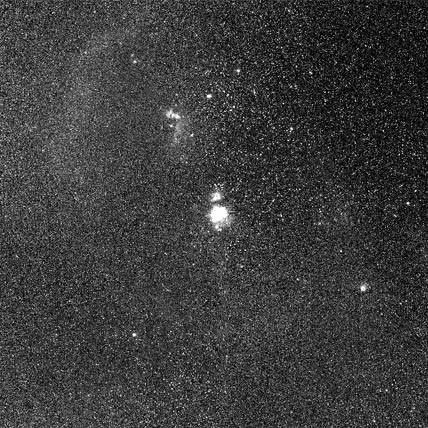
This little planet hunter could churn out big results. The SuperWASP cameras, with apertures of just 111 millimeters (4.4 inches), will measure the brightnesses of many thousands of stars with each shot. Buried in this data astronomers expect to find slight, periodic dimmings of stars by giant planets crossing their faces. (SuperWASP stands for Super-Wide Angle Sky Patrol.)
Courtesy SuperWASP project.
An array of modest cameras, using lenses you can buy in a photo store, has begun work in the Canary Islands searching for planets orbiting distant stars. The builders of the SuperWASP instrument expect it to discover new planets by the hundreds.
You're forgiven if you find this hard to believe. But it's true.
One of the hottest trends in 21st-century astronomy is monitoring the brightnesses of vast numbers of stars to high precision with CCD cameras — a technology that will relegate visual variable-star observing to the history books. One motivation is to discover Jupiter-size planets transiting across the faces of stars and dimming their light slightly at regular intervals. More than 20 projects worldwide are now engaged in such work.
Some of these programs, such as OGLE-III and MOA, watch millions of very faint, distant stars in relatively small parts of the sky. Others watch wider sky regions for variability in brighter stars; these include STARE on Tenerife in the Canary Islands, PSST at Lowell Observatory in Arizona, Sleuth at Palomar Observatory in southern California, Vulcan in central California, Vulcan South at the South Pole, HAT at Whipple Observatory in Arizona, and the amateur TASS project at various sites.
By far the most powerful wide-sky monitor to date began work on April 16th. SuperWASP, located atop La Palma in the Canaries, consists of five 200-millimeter f/1.8 Canon lenses (eight by later this year) mated to large, state-of-the-art CCD chips. The 2,028-by-2,028-pixel chips give each camera a field of view 7.8° by 7.8° in size. An array of four cameras covers an area wider than the constellation Orion in a single shot, as shown (greatly compressed) below. Software measures the brightness of nearly every star in the frame from magnitude 7 to 13 with a precision of about 1 percent (0.01 magnitude). A second copy of the instrument for the Southern Hemisphere is in the works.

Fifty thousand stars were recorded in this 1-second exposure by the camera array shown above — and the brightness of almost every one of them can be measured to 0.01-magnitude precision or better. During normal observing, exposures will be 30 seconds long. This 15°-square field is centered on the southern half of Orion. The bright patch is the Great Orion Nebula. Visible to its upper left is the Flame Nebula-Horsehead Nebula complex; the three bright stars of Orion's Belt extend upper right from there. The bright star at lower right is Rigel.
Courtesy SuperWASP project.
Each clear night's observing will produce about 800 frames per camera, totalling up to 60 gigabytes of raw star-brightness data. After processing, the data will be made available on the internet to anyone who wants to search it for interesting things happening. In addition to finding transiting planets, SuperWASP should be invaluable for discovering and monitoring all kinds of variable stars, hunting for near-Earth asteroids, early detection of extragalactic supernovae, and catching transient events such as gamma-ray bursts.
For discovering planets, however, the problem turns out not to be seeing transits, but distinguishing them from the much more common "false positives" that mimic them. The red herrings include transits across a star by a small stellar companion, normal eclipsing binary stars with grazing eclipses, and eclipsing binaries whose light is blended with a brighter third star, perhaps far in the foreground or background. Today's planet-transit searches "are inundated by astrophysical false positives," write David Charbonneau (Caltech) and five other astronomers in a recent paper. Astronomers will need to develop good automatic procedures to sort out most of these before transiting-planet discoveries can become routine.
 0
0
Comments
You must be logged in to post a comment.